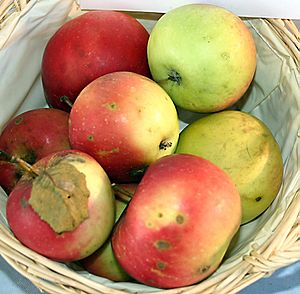Jonathan (apple) facts for kids
Quick facts for kids Malus domestica Jonathan |
|
|---|---|
 |
|
| Species | Malus domestica |
| Cultivar | Jonathan |
| Origin | Woodstock, New York, before 1826 |
The Jonathan apple is a popular type of sweet apple with a little bit of tartness. It has a tough but smooth skin. This apple is great for eating fresh, and it's also perfect for cooking delicious meals! It's related to another apple called the Esopus Spitzenburg apple. Jonathan apples have about 14% sugar, 9 grams of acid per liter, and 5 milligrams of vitamin C per 100 grams.
Contents
The Story of the Jonathan Apple: Its History
The Jonathan apple has an interesting past, with two main ideas about how it first appeared.
One idea says that a woman named Rachel Negus Higley grew it. Mrs. Higley collected apple seeds from a cider mill in Connecticut. In 1796, her family moved to Ohio. There, she planted the seeds and carefully grew her apple orchard. She named the new apple type after a young boy who often visited her orchard: Jonathan Lash.
The other, more widely accepted, idea is that the Jonathan apple came from an Esopus Spitzenburg apple seed. This happened in 1826 on Philip Rick's farm in Woodstock, Ulster County, New York. At first, it might have been called the "Ricks" apple. But soon, Judge Buel, who was the head of the Albany Horticultural Society, renamed it. He named it after Jonathan Zander, who found the apple and showed it to Judge Buel.
Apple Family Tree: Jonathan's Descendants
Many other apple types have been created using the Jonathan apple as one of their parents. Here are some of its "descendants":
- Jonagold—This apple is a mix of the Jonathan and Golden Delicious apples.
- Jonamac—This apple is a mix of the Jonathan and McIntosh apples.
- Rubinstar
- Idared
- Melrose
- Undine
- Akane
- Querina Florina (This type is good because it can resist apple scab disease.)
Keeping Jonathan Apples Healthy: Common Diseases
Like all plants, Jonathan apple trees can get sick. Here are some common diseases that can affect them:
- Scab: This disease causes spots on the leaves and fruit. Jonathan apples are very likely to get it.
- Powdery mildew: This looks like white powder on the leaves. Jonathan apples are very likely to get it.
- Cedar apple rust: This disease causes orange spots on leaves. Jonathan apples are very likely to get it.
- Fire blight: This makes branches look like they've been burned. Jonathan apples are very likely to get it.
See also
 In Spanish: Jonathan (manzana) para niños
In Spanish: Jonathan (manzana) para niños

